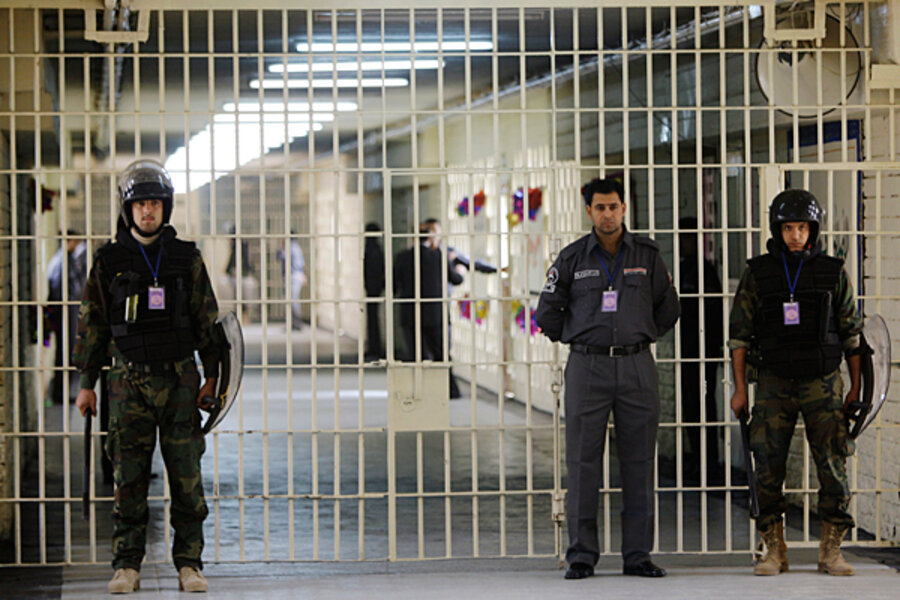How many jihadis just escaped from Abu Ghraib?
Loading...
Sophisticated overnight attacks on two Iraqi prisons on the outskirts of Baghdad involving mortars, rocket-propelled grenades, and dozens of attackers are a sign of growing potency for the country's Sunni insurgents.
These weren't attacks on mosques or markets, designed to spread terror by killing unprepared civilians in public spaces. These were attacks on the militarized prisons of Abu Ghraib and Taji, both of which have large contingents of insurgents among their inmates and have long been targets for Iraq's jihadis. Yet the government of Shiite Prime Minister Nouri al-Maliki was forced to scramble attack helicopters and rush troops to join pitched battles. Even so, they may not have staved off a stunning symbolic defeat.
Though early today government officials claimed the attackers had been kept from their ultimate objective – freeing jihadi comrades – as the day wore on scattered claims were made of a stunning insurgent success. Member of Parliament Hakim al-Zamili asserted to Reuters that 500 insurgents escaped from Abu Ghraib alone and that most of them were members of the Al Qaeda-aligned Islamic State in Iraq.
Iraq's al-Summaria TV also reported that hundreds of Al Qaeda fighters escaped from Abu Ghraib and Taji, citing an unnamed police source, and went on to say that many of them were from Saladin Province, which lies between the insurgent hotbed of Anbar and the increasingly troubled province of Mosul due to its border with Syria. But TV stations frequently get stories wrong when relying on unnamed sources. And Mr. Zamili, as a loyalist of Shiite preacher and Maliki opponent Muqtada al-Sadr, would have reasons to favor a story that embarrasses the prime minister.
Whether this was a total disaster or just the latest in a series of black eyes for the government remains to be seen, as does the death toll. Early reports claim that 20 soldiers and policemen died in the jailbreak and that roughly that many of the prisoners were killed. How many of the insurgent assault forces died has yet to be determined.
But what's already clear is light infantry attacks involving a large number of insurgents and weapons, that must have been long planned, were carried out against government forces on the outskirts of Baghdad, the seat of central government power. Iraq's sectarian civil war in some ways never really ended, US protestations that the "surge" brought peace to Iraq to the contrary. The Shiite dominated government has behaved autocratically, clamped down on freedom of speech, continued the tradition of torture in Iraq's prisons and police stations, and cut Sunni Arabs out of the political process.
Not surprisingly some of the Sunni Arabs who were promised a seat at the table in the "new Iraq" but have instead been systematically marginalized are taking up arms again. Lately they've been given heart by Sunni jihadi successes across the border in Syria (where Bashar al-Assad is allied with Shiite Iran and enjoys at least the tepid support of the Maliki government), with Iraqi jihadis from Anbar and other border provinces playing a prominent role in the Jabhat al-Nusra insurgent group, and those returning home reinvigorating their comrades.
AFP statistics show that 527 Iraqis died in insurgent violence this month through July 20 and there have been at least 100 further killed in the two days since, making July the deadliest month of the year – and the deadliest month in Iraq since June 2008. The previous deadliest month in Iraq since June 2008 was this May.
While Sunni jihadis frequently execute prisoners and prey on defenseless civilians for either working with the government or simply being Shiites, an attack on Abu Ghraib carries powerful symbolism for Iraq's Sunni community in general.
The prison there was a house of horrors under Saddam Hussein, where political opponents (most Shiite but many Sunnis as well) were tortured before their execution. The disfigured body of a loved one returned to a community formed a powerful disincentive to standing in his way. After Hussein was deposed by US-led forces in 2003, Abu Ghraib's administration came into the hands of the US Army, which in turn carried out torture on inmates, many of them Sunnis accused of being insurgents.
Pictures of the torture conducted by US guards leaked out and in 2004, and indelibly stained America's reputation in the country and much of the region. Abu Ghraib was long ago returned to Iraq's government, but succeeding Iraqi governments have made torture far more widespread and routine than it was when the US was running the country. While the worst abuses under Maliki's rule have taken place in secret prisons co-located with Iraqi Army bases and Interior Ministry facilities, Abu Ghraib remains a symbol of central government abuse. And the ongoing torture fuels Iraq's separation and violence, rather than quelling it.
Iraq remains a long way from the worst of the civil war. The vast majority of Iraqis who lived through it don't want to return to that horror. But the war in Syria has seen Iraq's already limited control of that long border slip, and government failures like that today – which potentially saw hundreds of seasoned operatives re-injected into the Iraqi insurgency – will encourage more Sunni fence-sitters to join the fight.







